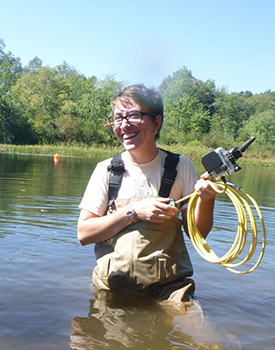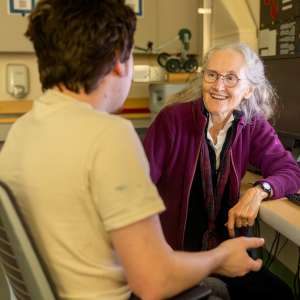Dr. Burchsted and Student Researchers Study Rivers after Dams are Removed

Lately, there’s been pressure from environmental groups to remove some of the old mill dams that are common in many New England towns. Basically, the feeling is that the dams alter the river’s habitat and create barriers to several important species of fish (salmon, smelt, shad, striped bass, sturgeon, and eels, for example) that must travel up and down the rivers to and from the ocean to spawn.
But when a group decides to remove one of these old dams, what do they do with the sediment that has built up behind it over the past couple of hundred years? Conventional wisdom has held that allowing that sediment to flow downstream would create an ecological disaster, burying and wreaking havoc on the organisms and habitat below, so it must be dredged out before the dam can be breached. However, some scientists suggest that these sediments can play an important role in restoration. Keene State’s Assistant Professor of Environmental Studies Denise Burchsted, whose area of expertise focuses on natural and man-made barriers in waterways, has been involved in a couple of dam removal projects south of the border in Massachusetts where the sediment was allowed to wash downstream.
What happened? In the Millie Turner Dam on the Nissitissit River in Pepperell, Massachusetts, there was the fear that taking out the dam would change the water level and the released sediment would harm an endangered freshwater mussel much farther downstream. However, the Massachusetts Division of Ecological Restoration (MA DER), made the decision to remove the dam and let the sediment flow, supported by input from the endangered species and fisheries experts with the Massachusetts Division of Fisheries & Wildlife and with the experts in dam safety at the Office of Dam Safety, among others. They decided on that route because the Nissitissit is very productive for fish, including the fish that probably help maintain the endangered mussels, and the dam was a barrier to their movement.
Sedimental Journey
Because the sediment had been impounded for years, the stream bed for a mile downstream was impacted, and was often hard rock, a very unproductive environment for fish and other aquatic creatures, including the endangered mussel, to build nests and live. So Peter Hazelton with Mass Division of Fisheries & Wildlife, assisted by a team of volunteers relocated as many of the endangered mussels as they could find before the dam was taken out, and the sediment was allowed to move downstream in hopes of restoring the stream bed. Helped by funding from the Squan-a-Tissit and the Boston chapters of Trout Unlimited, some of Dr. Burchsted’s students – primarily Andy Marion, with some assistance from Joshua Dallesander, Charlie Stoll, and Hannah Beauchesne – were able to conduct research on the process.
Begin pull-quote…DER had tested the sediments for contamination and found them to be clean. It is common for impounded sediments to be contaminated, and releasing those is also a water quality issue. Needless to say, it’s a complex process to take out a dam. …end pull-quote
The students measured the sediment before the dam came out and are now conducting research on the downstream bed after the dam is gone. “So far, we’re finding that the sediment is moving very slowly, much more slowly than expected, and it has only started to show up downstream of the dam,” Dr. Burchsted explained. “It might take a year or so to really have a sense of the final impact.”
The research opportunity has been invaluable for Marion, an environmental studies major with a minor in women’s and gender studies. “I’ve been working with Dr. Burchsted since my first semester at Keene in fall 2014 and have been focusing mainly on this project, and I’ve learned so much from working with her, including developing my skills in field study, data management, communicating professionally about my work, and public speaking,” Marion said. “The broad collection of organizational and communication skills are probably the most important thing that I have gained from this experience, and those are vital to becoming a professional in any field. I also was trusted to supervise fellow students in the field, which gave me a great deal of leadership experience.”





